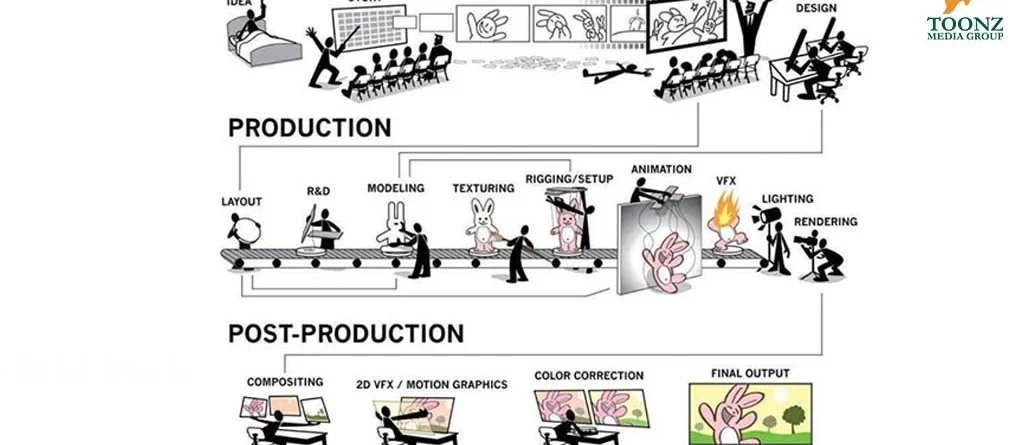Behind the Scenes: A Sneak Peek into the Animation Production Pipeline
admin2023-06-26T09:46:43+00:00Animation is a captivating art form that brings characters and stories to life through the magic of moving images. But have you ever wondered how animated shows and movies are created? The process can be complex and involves various stages. Animation production is typically divided into three main stages: pre-production, production, and post-production. To ensure a smooth workflow and efficient collaboration, the animation industry relies on a production pipeline. In this article, we will delve into the steps of the animation production pipeline, shedding light on the behind-the-scenes process of creating animated content.
Pre-production
Step 1: Animation Project Strategizing:
Every animation project begins with strategizing. The production team defines the project’s goals, target audience, budget, and timeline. This step lays the foundation for the entire production process, ensuring that everyone involved is aligned with the project’s objectives.
Step 2: Story Conceptualization and Animation Scriptwriting:
The next step is to develop a captivating story. The creative team brainstorm ideas, create engaging narratives, and craft a compelling storyline. Once the story is finalized, animation scriptwriting begins. This involves translating the story into a written script, detailing the dialogues, scene descriptions, and key storytelling elements. The script serves as a blueprint for the animators, guiding them in bringing the story to life.
Step 3: Art Direction and Character Design:
Art direction and character design play a crucial role in shaping the visual style of the animation. The art director collaborates with the team to define the overall aesthetics, color palette, and mood. Character designers bring the protagonists and supporting characters to life by creating their appearances, costumes, and personalities. This step ensures that the animation has a distinct and visually appealing look.
Step 4: Voice Recording:
Dialogue recording captures the character dialogues, working with voice actors to bring the desired emotions and performances to the animation.
Step 5: Storyboarding and Animatics:
Storyboarding is the process of visually planning the animation sequence. Storyboard artists sketch out the key scenes, shot compositions, and camera movements, providing a blueprint for the animation. Animatics take storyboarding further by adding temporary sound effects, voiceovers, and music. It helps in determining the timing and pacing of the animation before the final production begins.
Production:
Step 6: Background Layout:
Before the animation process begins, designing the background layout is a crucial step in creating immersive environments. Background layout artists work closely with the art director to bring the settings and backdrops to life. They meticulously craft the landscapes, architecture, and details that form the backdrop of the animation. The background layout sets the stage for the characters and their adventures, ensuring that the visual aesthetics align with the overall style of the animation. By creating rich and detailed backgrounds, the animation gains depth, realism, and a sense of place, enhancing the overall storytelling experience.
Step 7: Key Animation and Effects Animation
Key animation is where the magic truly happens, as skilled animators breathe life into the characters. Frame by frame, the animators meticulously bring the characters’ movements, expressions, and actions to fruition. This process involves creating the essential poses and actions that define the character’s performance throughout the animation. The keyframes serve as the foundation, capturing the most significant moments and transitions. Once the key animation is complete, it becomes the blueprint for the subsequent stages, where additional frames and in-between animations are added to achieve seamless motion. Key animation is the heart of the animation process, infusing the characters with personality and making them truly come alive on screen. After the overall key animation is done, effects animation is added. Effects animation adds visual elements like explosions, fire, and magic to enhance the overall impact of the animation.
Post-production
Step 8: Editing
In the final stages, the animation undergoes editing to refine the timing, pacing, and overall flow of the story. The editor works closely with the creative team to fine-tune the animation, ensuring that each scene transitions smoothly and effectively.
Step 9: Sound Design, Music and Background Score:
Sound design plays a crucial role in enhancing the storytelling. Sound designers create and integrate sound effects, ambient sounds, and background music to create an immersive audio experience. Music and background score in animation are vital elements that enhance storytelling and evoke emotions. Composers work closely with the creative team to create original scores that capture the desired mood and themes. The background score is synchronized with the animation, accentuating the drama and adding depth to the storytelling. Sound designers craft sound effects that bring the animation to life, immersing the audience in the on-screen action. Together, music and background score elevate the animation, creating a captivating and emotionally resonant experience.
Step 10: Animation Color Correction and Color Grading, Compositing, and Final Revisions:
Color correction and color grading ensure consistency in the color palette and enhance the visual aesthetics of the animation. Compositing involves combining various elements, such as characters, backgrounds, and effects, into the final frames, adding depth and visual effects. The animation goes through multiple revisions based on feedback and critiques to refine the storytelling, animation quality, and overall coherence of the project.
Step 11: Run-through, and Rendering the Animated Video
Once the final visual and audio edit is complete, a run-through of the entire animation is conducted. This step allows the team to review the animation as a whole, identifying any issues or inconsistencies that may need to be addressed. It serves as a final quality check before the animation is ready for rendering.
Rendering is the process of converting the digital data of the animation into its final form. This step involves using specialized software and powerful computers to generate the individual frames of the animation. It can be a time-consuming process, especially for complex animations with high-quality visuals. Patience and attention to detail are crucial during rendering to achieve the desired outcome.
The animation production pipeline is an essential framework that enables animation studios to bring their creative visions to life. It provides a structured and organized approach to the complex process of creating animated films and shows. By following the pipeline, artists and production teams can effectively collaborate, manage time and resources efficiently, and maintain quality control throughout the production process. The pipeline ensures that each step, from strategizing and conceptualizing the story to rendering the final animated video, is executed in a systematic manner. It allows for creative freedom while providing checkpoints and revisions to maintain the intended vision and storytelling. By embracing the pipeline, animation professionals can create captivating animations that captivate audiences and leave a lasting impact.
So, the next time you watch an animated show or movie, remember the intricate behind-the scenes process that brought it to life. The animation production pipeline is the backbone of the industry, ensuring that creativity and technical expertise come together to create mesmerizing worlds and unforgettable characters
Find more trending information on: https://toonz.co/

